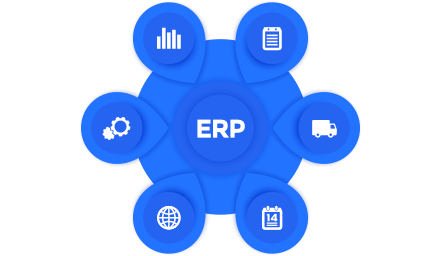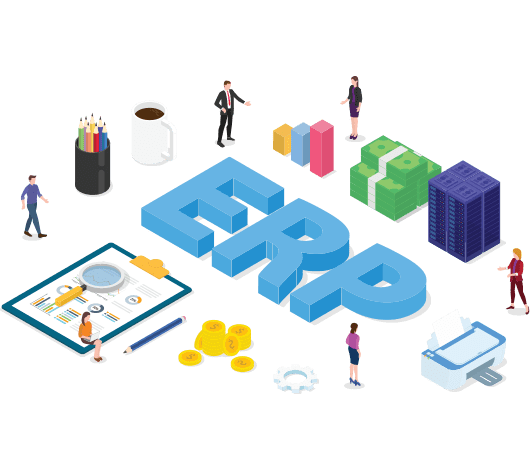
Request a Call Back
Enter your contact details and One of our executives will be in touch soon!
OR
Get In Touch
Please fill out the form above if you have a plan or project in mind that you'd like to share with us.

WEBINGO® is a renowned end-to-end IT solutions company in India that provides ultimate IT solutions and has provided consultancy to numerous start-ups across India.
If you just help your customers, or help your buyers buy, and answer the questions that
they have in that journey, then you can really succeed.
Bring down the entire ownership and operational cost with ERP. Easy supply chain management system and customer handling, vendors, partners, suppliers, and much more along with your finances, inventory, manufacturing, etc. As one of the esteemed ERP companies in India, WEBINGO blends the power of cloud and mobile to drive operational efficiency for a business irrespective of the size or vertical it operates. WEBINGO ERP is the perfect pick for you to not only streamline critical business processes but also help scale rapidly.
Request A Quote

ERP stands for Enterprise Resource Planning which functions as a massive database for your company. ERP software automates data collection, organization, and analysis, and shares it with the concerned teams in order that they will work to their best abilities. The ERP system was essentially built to help businesses automate their financial capabilities but it soon found usage in other core functions as well i.e. Human Resources, Marketing, Finance, Logistics to call a few. Traditional ERP systems can become a liability if not executed properly, that's where Webingo comes in. Say goodbye to business challenges such as operational inefficiencies, data duplication, and downtime with WEBINGO - a robust ERP software provider in India. WEBINGO is a renowned ERP provider for industries of all sizes in entire India.
• Better reporting tools with real-time information.
• A single source of truth – one integrated database for all business processes.
• Improved inventory planning.
• Better procurement management.
• Better customer service.
• Improved vendor relationship management.
• Only carry required Inventory.
• Too much inventory, and higher overhead costs.
• Too little inventory, and longer customer fulfillment times.
• Better invoicing and better collections tools to bring advantage faster.
• Faster cash means additional cash available for the business.
• Better access to customer information.
• Faster response times.
• Improved on-time delivery.
• Improved order accuracy.
• Dedicated security resources.
• Avoid installing malicious software.
• Data distributed.
• Across multiple servers.
A major impediment for evolved businesses such as manufacturing and supply chain is an information silo. A business suffers immensely if it is difficult for information to flow freely within different departments. ERP systems, with its vast integration capabilities, offer a solution to this problem. Moreover, in recent years, functional capabilities of ERP systems have only increased as it now encompasses Human Resource Management, Business Intelligence, Financial Statistics and much more in its ambit.
Enquire NowThis first phase begins during the sales process and then continues post-sale. During this period, the project team will be created. There will be initial meetings and documentation developed as the team works to identify current issues and potential solutions. An important part of this phase is constructing the project plan, which will serve as a guide throughout the rest of the project.
We’re not talking about painting the office or rearranging furniture. Instead, what will the new enterprise-wide system look like and how will it be used in the organization? In the ERP Design phase, the project team and implementation team will be working out the various configurations for the new system, defining roles, and documenting standard procedures.
This includes activities such as completing any necessary customizations, developing user trainings, and importing data. With ERP implementations, like any custom software development projects – “First, Solve the problem. Then, write the code.”
Is the system’s functionality aligning with the requirements? The Testing and Development phases will often overlap, as the implementation and project teams jump between the two – constantly fine-tuning the configuration. By the end of this phase, project team members will be comfortable doing their jobs in the new system. This is the final step before diving into the live system.
The project team and implementation team will assess the situation and make the final go or no-go decision. Prior to going live, the final data will be loaded and validated. The project team will train other employees who will then start working in the new system, and completely stop using the old one. With this final check, we finalize everything.
Once the ERP system has gone live, the purpose of the project team will shift. Over time, as the way the users work within the system evolves, adjustments, and changes to the system configuration may be needed. It may include bug fixing with other services taken.
Webingo empowers businesses with seamless process management in its entirety from production to delivery.
Complete proficient team with all round and best service.
Our happy customers speak for our work.
We have a team with people who are expert at what they do.
Friend, humble and patient service team.
On time delivery because we value your time.
Timely report to maintain transparency.
Want to start a new project?
Enquire NowERP is an acronym that stands for Enterprise Resource Planning. But what does that really mean? ERP software is designed to help companies manage their business operations, providing visibility into available resources, whether financial, labor, time, materials or other aspects needed. Organizations use ERP software to streamline the complexity of business processes such as taking orders, scheduling plant activity, tracking raw materials and compliance reporting. Virtually every organization with more than a few employees uses some form of ERP. It’s a competitive disadvantage if a company isn’t leveraging ERP effectively.
Many companies adopt ERP for the first time when they realize their entry-level accounting software lacks core functionality, scalability and just isn’t giving them the visibility they need. But ERP software systems help you manage much more than financials. An ERP system like SYSPRO’s is developed in a modular way, with applications covering such diverse areas as manufacturing management, distribution logistics, CRM, order management, e-commerce, product lifecycle and engineering control, scheduling, inventory and warehouse management..
When it comes to change, pain is a great motivator. Maybe it’s taking longer every month to reconcile your financials or you’re increasingly basing forecasts on guesswork. You have no real idea how much stock you have on hand, so it’s hard to be demand-driven. Increasing compliance regulations are tying you in knots. Here are five common signs we see from companies ready to consider a new ERP software system:
1.Decision time has doubled. Time spent looking for information has increased dramatically.
2.Working capital has increased. Too much money is tied up in inventory and inefficient processes.
3.Redundant, disconnected software programs. You need to reduce IT complexity and unify your various front- and back-end systems with a single database – and get to one version of the truth.
4.Customer experience is suffering. If you can’t deliver what customers want, as fast as they want, to the right locations, you could lose to competitors. The right ERP system can provide visibility and agility to be more customer responsive and reduce errors.
5.Growth and expansion. If your current system can’t scale up, handle global needs, or support new business lines, it’s time to consider a change.
Making the right choice may seem daunting. But it doesn’t have to be. If you need help developing a list of requirements, find a vendor that knows your industry and market and has customers similar to your business. Once you have a list of requirements, you can then gather responses and start the comparison process. To help you select the right ERP solutions for your business and business needs, SYSPRO offers a preliminary assessment and modeled blueprint of your business based on evaluating your current and future strategic objectives, current business processes, IT maturity of your organization, people and roles involved in ERP and your information needs.